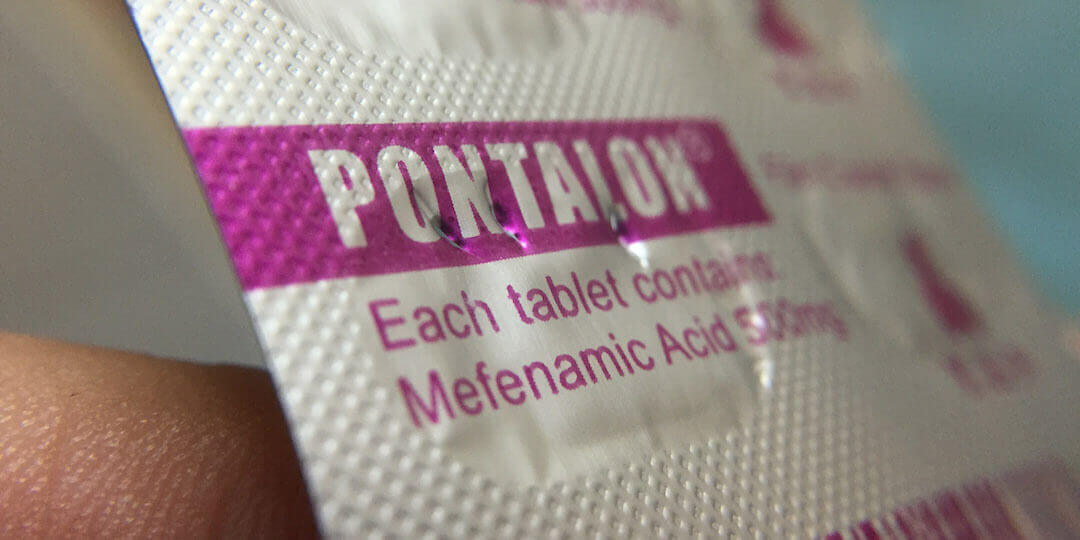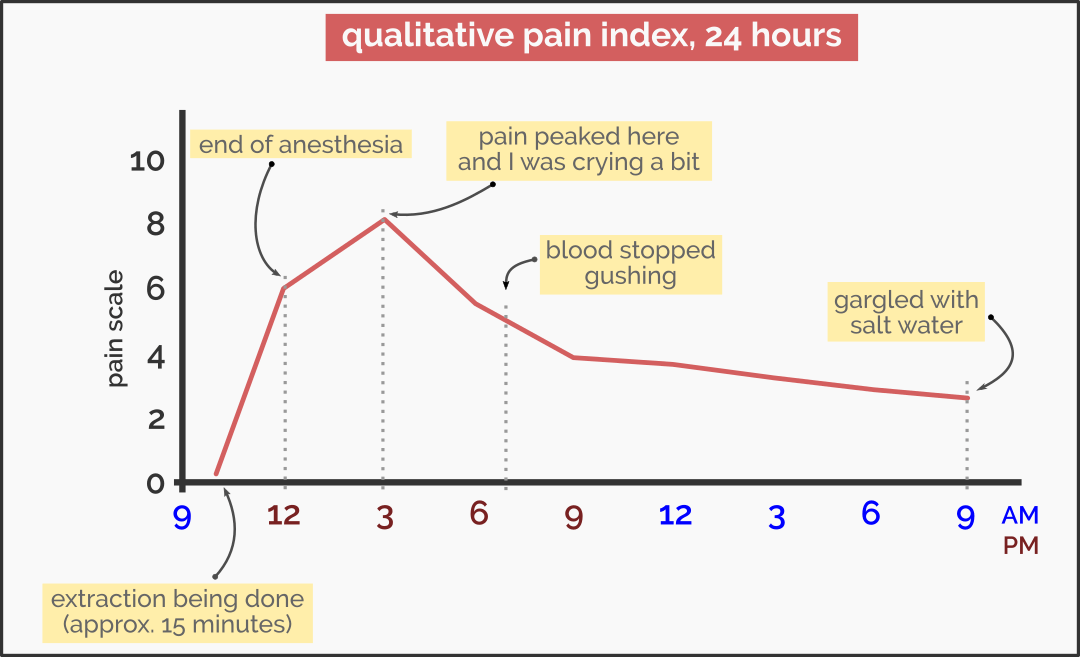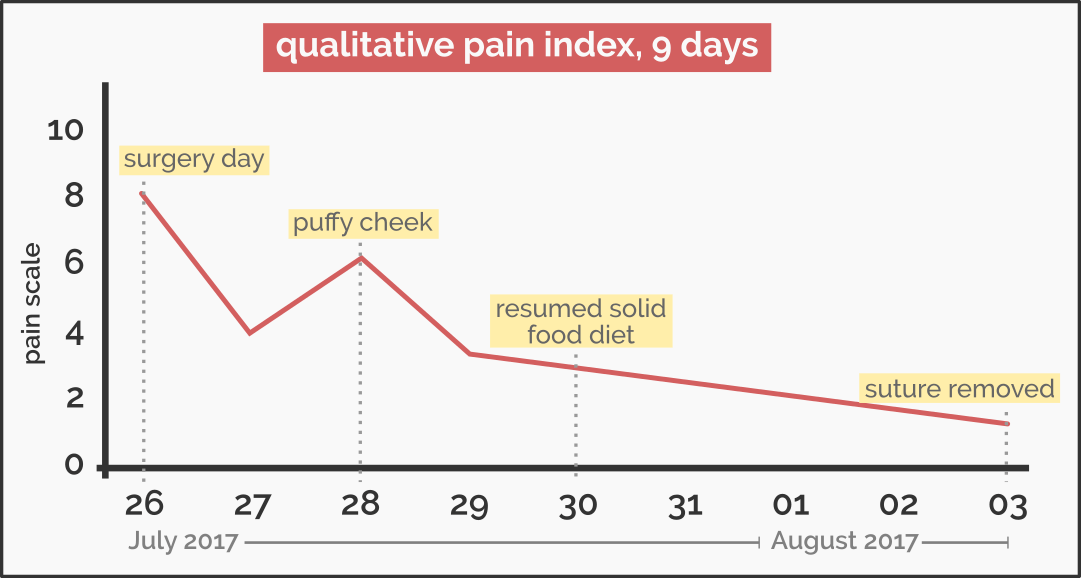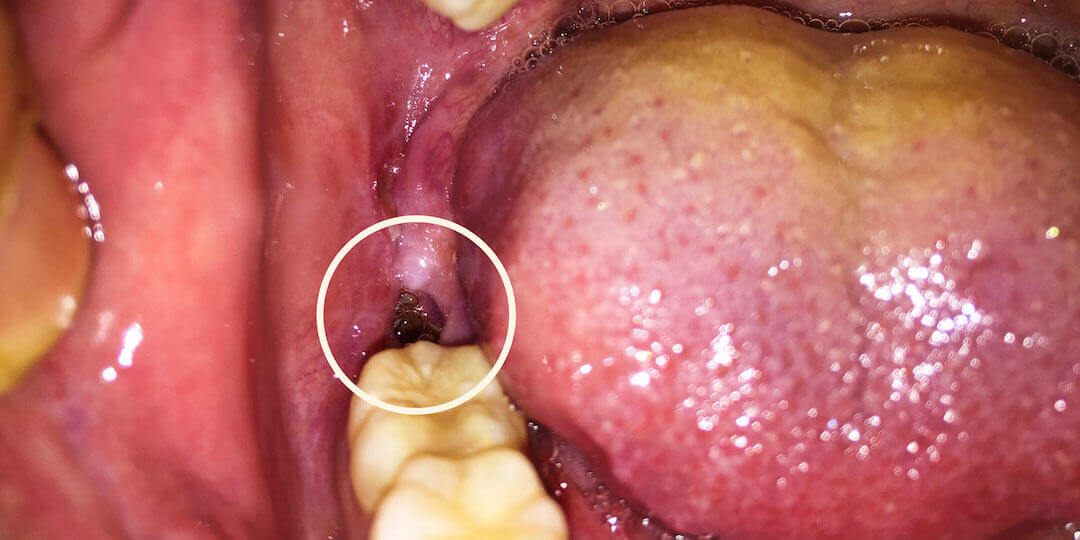A careful planning since April 2017 came into motion on July 26 when I finally decided to get a dental treatment to remove my third molar, colloquially known as the wisdom tooth. It was a valuable experience so I thought I should write this up and share it with my friends.
Who does not love a story when it involves blood, right?
The event took place on the morning of July 26th. I went to a dental clinic that was about 10 minutes from my home by car. Weeks before that I came to the same clinic to have a dental check-up. The dentist confirmed both wisdom teeth were impacted, and one those two got infected (lower right jaw). An extraction was recommended to prevent further complications. Both wisdom teeth were kind of slanted 45 degrees and were located in the lower jaw.
“Oh hi, I am here to get the third molar extraction”
“Oh yeah sure, sit down and let us anesthetize you”
The brevity of the process without paperwork was something I really appreciated. However, it did not leave a sufficient room for a full brief about the procedure. Other people might not be interested in such details, but being a scientist I wanted to know every nuts and bolt of the operation. Local anesthesia (LA) was administered (oh my the needle was kind of huge) and I was told to relax for about five to ten minutes.
“Oh you may go outside now, sit down and read some stuff”
I started tweeting and the moment the LA took effect, I tweeted:
“It is happening! I am now undergoing a dental surgery to remove wisdom tooth. Just got anesthetized. Told to go outside”
And that tweet became a thread, which was a good thing. Live-blogging is a good way to share experience, but apparently, most of my friends were all very supportive in the wrong way which I was rendered scared shitless.
The extraction procedure lasted around 14 minutes. How was it? Well, it was not painful but it was sort of uncomfortable for three reasons. First, the LA made my cheek felt puffy, and I expected as such. Second, the dentist and her assistant used some kind of extreme force to remove the third molar, and I also expected that beforehand. Third, the jaw had to be wide open for 14 minutes made it harder to swallow saliva, not to mention the dental suction kept my mouth dry, but what could I do? No, I am not complaining, I am just illustrating the procedure from the patient’s perspective.
Right before the surgery, I asked the dentist what kind of suture I would get. Per a friend of mine, there are two types: resorbable and non-absorbable. The resorbable suture is cool because it dissolves over time, eliminating the need for another appointment to remove it but it is a little bit pricey. The non-absorbable suture is less cool because you need another appointment, but it is less expensive. The clinic did not have resorbable suture so I was left with the non-absorbable one, which she informed it was called the black silk. I told myself “black silk is a cool name so let’s go with that”.
The extraction was a success and suture was in place. The procedure came with a price tag of MYR320 (USD75). I know, dirt cheap in USD, right? Last time I checked, the cost of this procedure in the United States hovered in the neighborhood of $250 - $800, depending on the complexity and how many teeth are involved. Just so you know, extracting just one wisdom tooth will only require local anesthesia, but removing all four at once (a rare case) will warrant a general anesthesia, to which you should not get that unless you really have to. This is due to the fact that usually a general anesthesia comes with a long checklist.

I was prescribed with three medications: mefenamic acid (painkiller and anti-inflammatory agent), antibiotics (to prevent infection), lysozyme chloride (anti-inflammatory agent), and two small bags of folded gauze pads to plug the bleeding. Anesthesia did not stay there for long. About three to four hours post-operation, the tingling feeling grew into a blunt throbbing pain intertwined with sharp pain. I think it would help if I show you my pain index 24 hours post-operation.

No the blood was not gushing but exaggerating it is the way to illustrate the horror of dealing with the blood coming out of the bleeding tooth socket. I kept on changing the folded gauze pad once in 20-40 minutes, sometimes every 90 minutes because I slept. Yes, I managed to get some sleep even though the pain was ablaze.
I browsed WebMD just to be sure I was not having post-surgery complications. It mentioned the dry socket issue, which could be debilitating and could be a precursor to a painful episode of bacterial infection. Luckily, dry socket is a quite rare phenomenon and it did not happen to me. My friends exchanged words of advice and potential hysterical fears of what could go wrong, both on an equal magnitude. I was told to gargle with salt water about 24 hours post-surgery. This should help to freshen the mouth and to speed up the recovery process.
The following days starting from July 29 – Wednesday 5, I had to go to the Kuala Lumpur to complete my travel documentations at the U.S. Consulate and I needed to notify my sponsor (MARA) that I had graduated last May. Had I done this dental extraction a week earlier, I would’ve not attracted some attentions because my right cheek was so puffy and I kept on massaging my cheek like I just got punched with a chair in the face. Thankfully it was only one side. If both sides, I would have an appearance with the same quality of a pufferfish but with a lung and two pairs of limbs.
Pro-tip: the painkiller, mefenamic acid, is not just a painkiller. It is an anti-inflammatory agent belongs to the NSAID class. It simply means “take it so you won’t have a super-swollen cheek”.
The swollen cheek took effect about two days post-surgery (on July 28). I woke up with a very weird feeling on my right jaw, and I thought I was still dreaming. I had this thought to punch my right jaw just to be sure but my subconscious self spared me pain from doing such a foolish act. The pain grew as the day passed to a point swallowing saliva felt like dragging my face on a hot tarmac. Yes I am exaggerating now so deal with it. But, it did not stop just there. In fact, the pain was coupled with canker sores. What a great time to have canker sores. If I counted correctly, I got three of them. What could be much worse than this, right?

On day 4, I started resuming solid food diet (rice, meat, noodles) after 3 days on soft food (yogurt, porridge, etc). I was careful enough not to overuse my right jaw. Brushing teeth required a little bit of attention to not aggravate the tooth socket. I noticed there was white precipitate like a puss. I was really curious to a point I touched it (don’t!) and tried to dislodge it with my tongue (a big, fat, obese, DON’T). It is called granulation tissue and it poses no threat. In fact, it is a sign of recovery and should not be touched with bare fingers.
The pain and swelling subsided on day 6 and eventually on day 9 (August 3), I had the suture removed. The removal of the suture was painless. On top of that, I had another minor treatment on that day to treat an infection for the tooth next to the extracted third molar. A dental filling was done with resin-based material and the whole thing took less than 15 minutes.

This picture is horizontally inverted. The long-forgotten wisdom tooth was on my lower-right jaw. It took me five attempts to get this picture and I even had to use a macro lens. If you want to do something like this, do it with when you have decent lighting.
Now there is one question remains. Why do we even have wisdom teeth when they have to be removed? To answer this, we need to have a basic knowledge in vestigial structure and this knowledge resides in the realm of evolutionary biology, a controversial topic.
Our ancestors, oh oh when I say “our ancestors” in the biological sense, it refers to our distant ancestors, probably alive more than thousands of years ago. In an article published on Aeon, a dental anthropologist (phew, what a profession!) said that our distant ancestors had perfectly aligned teeth (thankfully orthodontics wasn’t a thing back then). Our distant ancestors were hunter-gatherer and they did not have tools to process meat and poultry. They only had strong teeth.
Over the time, we developed tools to process meat and poultry, which prompted an evolutionary mechanism that basically says “hey, we don’t need the third molar anymore, we can do just fine without all four of them”. Jaw became smaller and smaller but teeth did not. Eventually, problems such as crowding and slanted third molar became apparent.
In exchange of smaller jaw, what did the evolutionary mechanism traded with us? A bigger brain. And a bigger brain comes with the capability to think better. Sadly, only a few of us can properly utilize brain to its fullest extent.